Technically Speaking: Think Like A Bear, Invest Like A Bull

With the markets closed on Monday for the holiday, there is nothing to really update from this past weekend’s “Market Review & Update.”
My friends over at the wonderful investing site “SA”, which should be part of your daily reading, picked up the newsletter which generated several comments. The most interesting of which was the following:
“Thanks for the good dialogue concerning the markets. I will say that most often after I read your articles, I am ready to dig the bunker deeper to the next level lower and load it with another month of food and water. Hopefully, I can muster the courage to manage coming market volatility.”
While I certainly appreciate the comment, and understand his concerns, it also highlights one of the biggest mistakes many investors make over the long-term.
You Think Like A Bear But Invest Like A Bull?
The answer to this question is what I have come to term the “Broken Clock Syndrome.” There is relatively little argument that Dr. John Hussman is probably one of the smartest individuals in Finance. His analysis of market valuations, understanding of market dynamics and long-term secular cycles is rarely disputed. His analysis, along with many others such as Crestmont Research, John Mauldin, and even Jack Bogle, has suggested that forward returns in the markets should remain low.
Even the math suggests the same as I pointed out previously.
“If we use a market cap / GDP ratio of 1.25 and an S&P 500 dividend yield of just 2%, what might we estimate for total returns over the coming decade using John Hussman’s formula?
(1.063)(0.63/1.25)^(1/10) – 1.0 + .02 = 1.3% annually.
We can confirm that math by simply measuring the forward TOTAL return of stocks over the next 10-years from each annual valuation level.”
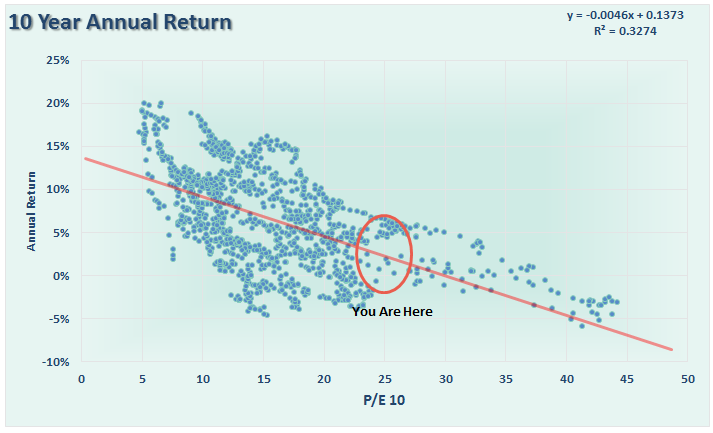
“Forward 20-year returns get worse.”
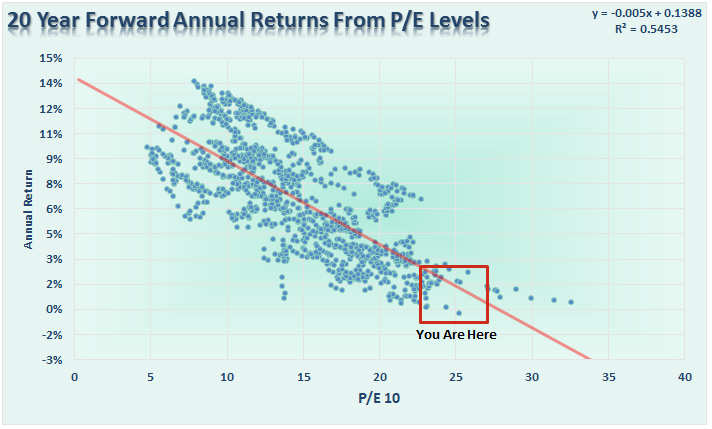
This suggests our commenter is correct and that cash is likely to be the best investment going forward. However, the flood of liquidity by Central Banks globally continues to elevate asset prices at historic extremes. The “Broken Clock Syndrome” is where investment decisions based solely on fundamental analysis can lead to poor outcomes when other dynamics take charge.
Like Hussman, and many others, I too am a value-oriented investor and prefer to buy assets when they are fundamentally cheap based on several factors including price to sales, free cash flow yield and high return on equity. However, being a strict value investor can eventually lead to a variety of investment mistakes, which I will discuss momentarily, when markets become both highly correlated and driven by speculative excess.
Currently, there is little value available to investors in the market today as prices have been driven higher by repeated Central Bank interventions and artificially suppressed interest rates. Eventually, the markets will begin a mean reversion process of some magnitude which will suppress the value of highly inflated “value” stocks that have been driven higher by investor’s “yield chase.”
However, when that reversion process occurs is anyone’s guess.
Therefore, while the analysis suggests that portfolios should be heavily under-weighted “risk,” having done so would have led to substantial underperformance and subsequent career risk.
This is why a good portion of my investment management philosophy is focused on the control of “risk” in portfolio allocation models through the lens of relative strength and momentum analysis.
The effect of momentum is arguably one of the most pervasive forces in the financial markets. Throughout history, there are episodes where markets rise, or fall, further and faster than logic would dictate. However, this is the effect of the psychological, or behavioral, forces at work as “greed” and “fear” overtake logical analysis.
I have discussed previously the effect of “full market cycles” as shown in the chart below.
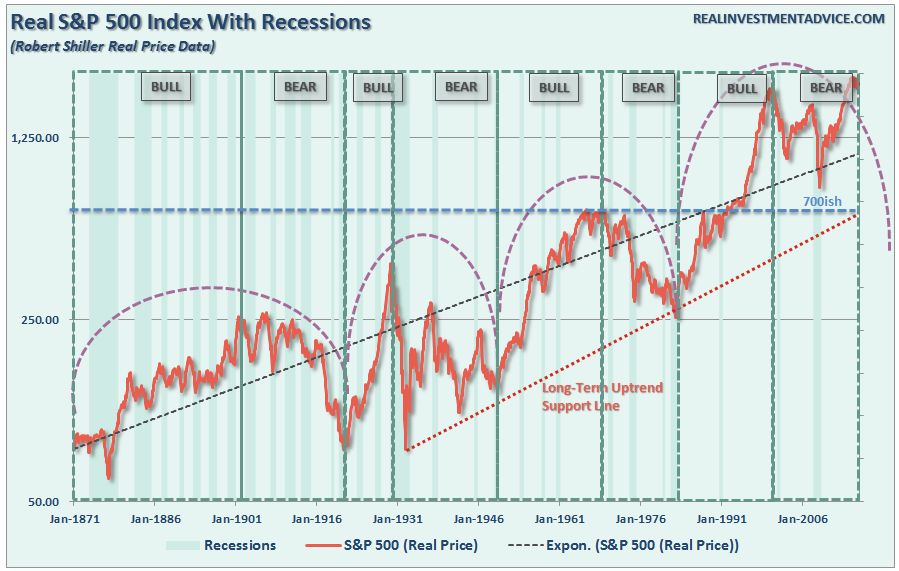
What is also important to note is that these full market cycles are ultimately driven by the economic cycle. As shown in the next chart, the sector rotation appears to lead the economic cycle.
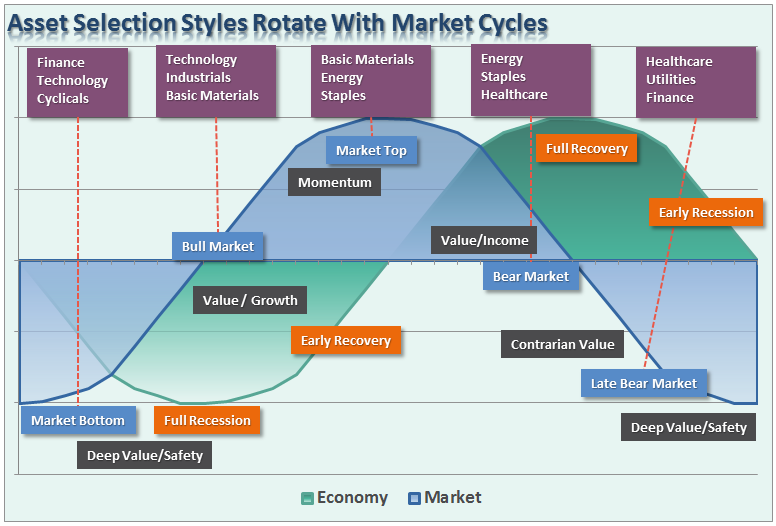
However, the “lead effect” in reality is much more coincident in nature. This is due to the fact that recessions are only revealed in hindsight once data is revised lower. This lag effect of the data revisions in shown below.
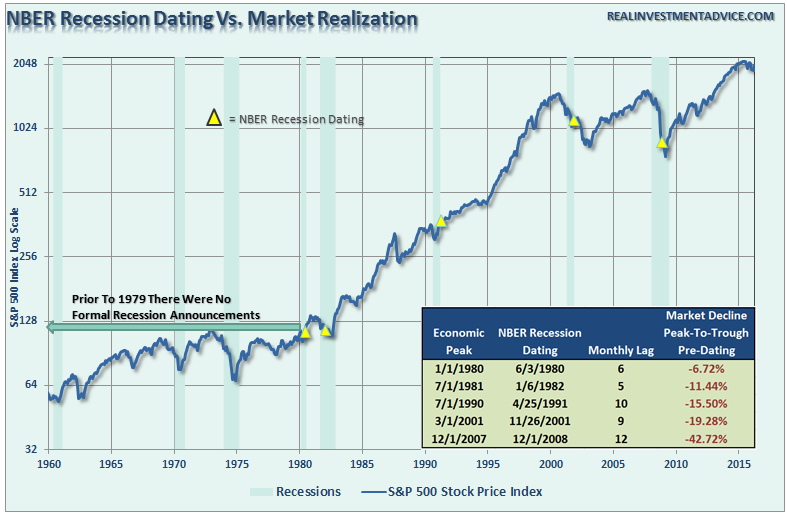
Importantly, it should be noted that investment styles also shift during the broader cycle.
- During recessionary bottoms, when assets are truly selling at “bargain basement” prices, deep discount value strategies tend to perform the best as investors are panic selling to find safety over risk.
- As markets begin to recover investor’s begin to cautiously re-enter the markets and begin to seek some risk with a degree of safety. Value oriented investment strategies will still work during while these early recovery cycles and growth strategies began to gain momentum.
- During the latter stages of the economic cycle, growth and value give way to pure momentum as investor “greed” and “exuberance” began to view “value” as “out of favor.”
It is during this stage of the cycle that “fundamentals appear not matter” as the fundamentally worst stocks lead the markets higher.
In other words, we begin hearing discussions of why “This Time Is Different (TTID)” and “There Is No Alternative (TINA).”
This cycle does end, and the reversion process back to value has historically been a painful one. It as this point investor’s begin to discuss being “F***ed Up Beyond All Recognition (FUBAR)”
Understand It, But Don’t Fear It
Currently, there is little doubt that we are in both the late stages of an economic cycle and a momentum driven market. Therefore, investment focus must be adjusted to current market dynamics that requires a focus on relative strength and momentum as opposed to valuation-based strategies.
There have been many studies published that have shown that relative strength momentum strategies, in which as assets’ performance relative to its peers predicts its future relative performance, work well on both an absolute or time series basis. Historically, past returns (over the previous 12 months) have been a good predictor of future results. This is the basic application of Newton’s Law Of Inertia, that states “an object in motion tends to remain in motion unless acted upon by an unbalanced force.”
In other words, when markets begin strongly trending in one direction, that direction will continue until an “unbalanced” force stops it. Momentum strategies, which are trend following strategies by nature, have been proven to work well across extreme market environments, multiple asset classes and over historical time frames.
While there is substantial evidence that market valuations and fundamentals are not supportive of asset prices at current levels, investor psychology has likewise reached extremes. In such an environment, it is also beneficial for investors to shift focus to momentum based strategies as trend-following strategies reflect the behavioral factors such as anchoring, herding, and the disposition effect.
Let me explain.
Fundamentally based investors are slow to react to new information (they anchor), which initially leads to under-reaction but eventually shifts to over-reaction during late cycle stages.
The other inherent problem of primarily data-based investors is the “herding” effect. As prices move higher, valuation arguments lose relevance. However, the need to produce investment performance in a rising market, leads to “justifications” to explain over-valued holdings. In other words, buying begets more buying.
Lastly, as the markets turn, the “disposition” effect takes hold and winners are sold to protect gains, but losers are held in the hopes of better prices later. The end effect is not a pretty one.
By applying momentum strategies to fundamentally derived investment portfolios it allows the portfolio to remain allocated during rising markets while managing the inherent risk of behavioral dynamics.
This is why, despite the fact that I write like a “bear,” the portfolio model has remained allocated like a “bull” during the market’s advance. The point is simple, our job as investors is to make money when markets are rising and too avoid potentially catastrophic losses when trends change.
It would be simple to regurgitate the bullish media mantra’s about why markets might go higher from here. You have CNBC for that. My job is to analyze the data for what potentially might go wrong and manage the risks related to loss.
We can debate the valuation metrics and argue with each other why markets should not be rising, and eventually those arguments will be correct. However, for now markets are rising, and we need to participate until the trends change to the negative. Of course, if your current portfolio management philosophy doesn’t have a method to understand when “trends” have changed, how will you know when it is time to step away from the poker table?
As Kenny Rogers once sang:
“If you’re gonna play the game, boy…You gotta learn to play it right. Every gambler knows that the secret to survivin’ is knowin’ what to throw away
and knowin’ what to keep. ‘Cause every hand’s a winner. And every hand’s a loser. You’ve got to know when to hold’em and know when to fold’em.”
Disclosure: The information contained in this article should not be construed as financial or investment advice on any subject matter. Streettalk Advisors, LLC expressly disclaims all liability in ...
more



As always great stuff. Less than a handful of analysts have spoken this way for the last decade. You, Gary Savage, Joshua Hayes come to mind